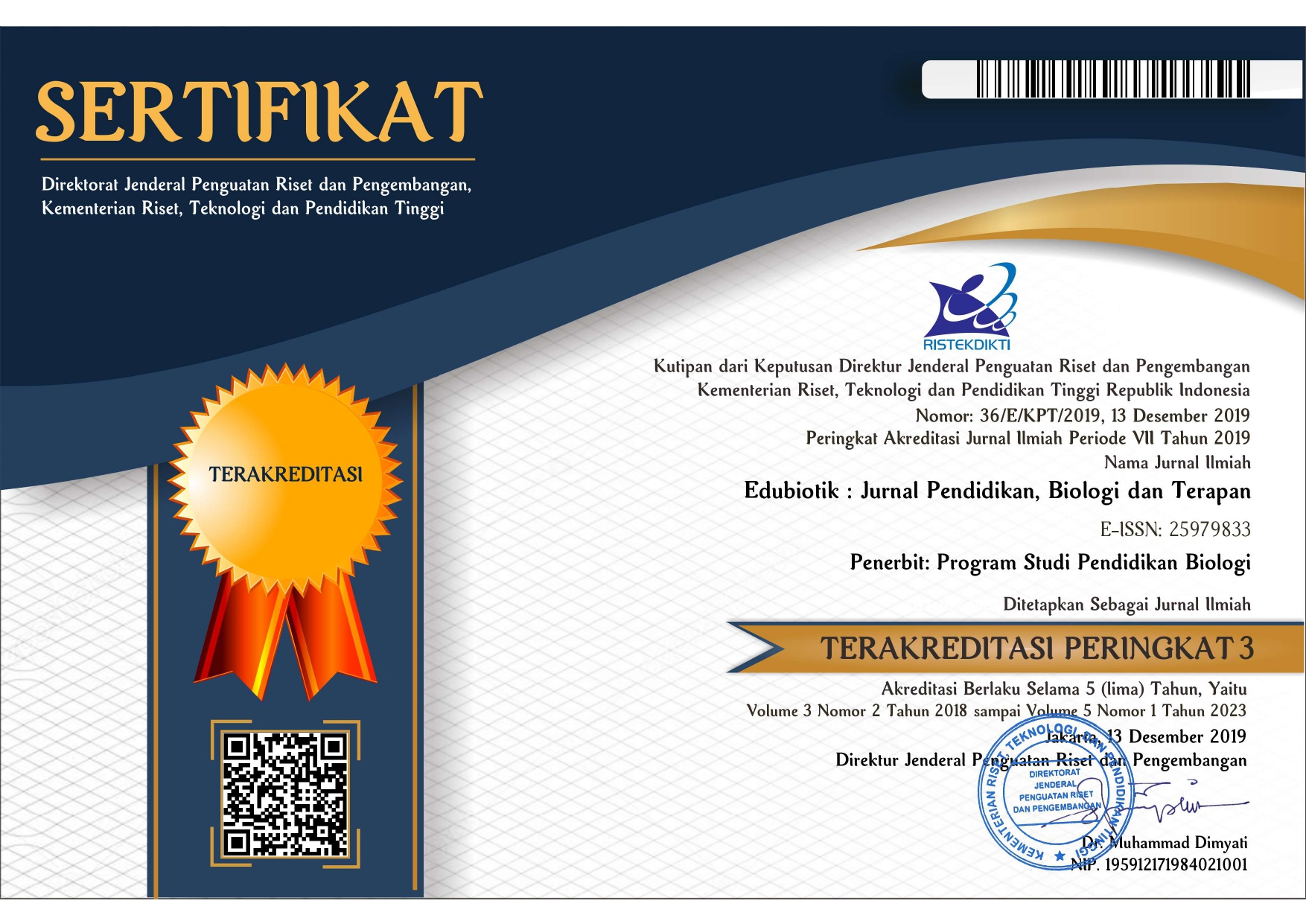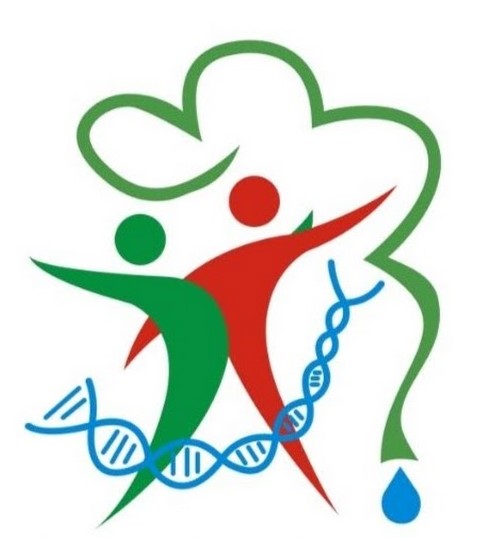Ability of greater duckweed (Spirodela polyrrhiza) to absorb cadmium and its potency as phytoremediator
Abstract
Phytoremediation is a method that uses the ability of plants to absorb pollutants in the environment both on land and in water. This study aims to explore duckweed which is a candidate for phytoremediator. Duckweed is a small aquatic plant that grows very fast. In this study, duckweed used is Spirodela polyrrhiza and cadmium was chosen as a model pollutant with concentrations of 0.05 and 0.1 ppm. Cultivation was done for 7 days. The specific growth rates in the 0.05 and 0.1 ppm treatments were decreased, 0.118±0.001 and 0.11±0.002 days-1, respectively, when compared to the control, 0.143±0.002 days-1. S. polyrrhiza was able to absorb cadmium with absorption capacity of 66.4 and 67.2 % at 0.05 and 0.1 ppm, respectively. These showed the potential of duckweed to be further developed as a phytoremediator for the environment.
References
Al-Baldawi, I. A. W., Sheikh Abdullah, S. R., Abu Hasan, H., Suja, F., Anuar, N., & Mushrifah, I. (2014). Optimized conditions for phytoremediation of diesel by Scirpus grossus in horizontal subsurface flow constructed wetlands (HSFCWs) using response surface methodology. Journal of Environmental Management, 140, 152–159. https://doi.org/10.1016/j.jenvman.2014.03.007
Ashfaque, F., Inam, A., Sahay, S., & Iqbal, S. (2016). Influence of heavy metal toxicity on plant growth, metabolism and its alleviation by phytoremediation - A promising technology. Journal of Agriculture and Ecology Research International, 6(2), 1–19. https://doi.org/10.9734/jaeri/2016/23543
Carlos, M. H. J., Stefani, P. V. Y., Janette, A. M., Melani, M. S. S., & Gabriela, P. O. (2016). Assessing the effects of heavy metals in ACC deaminase and IAA production on plant growth-promoting bacteria. Microbiological Research, 188–189, 53–61. https://doi.org/10.1016/j.micres.2016.05.001
Chaudhuri, D., Majumder, A., Misra, A. K., & Bandyopadhyay, K. (2014). Cadmium removal by Lemna minor and Spirodela polyrhiza. International Journal of Phytoremediation, 16(11), 1119–1132. https://doi.org/10.1080/15226514.2013.821446
Cuadrado, W., Custodio, M., Espinoza, C., Vicuña, C., & Uribe, M. (2019). Capacity of absorption and removal of heavy metals from <i>Scirpus californicus</i> and Its potential use in the remediation of polluted aquatic environment. Open Journal of Marine Science, 09(02), 74–85. https://doi.org/10.4236/ojms.2019.92006
Dixit, R., Wasiullah, Malaviya, D., Pandiyan, K., Singh, U. B., Sahu, A., Shukla, R., Singh, B. P., Rai, J. P., Sharma, P. K., Lade, H., & Paul, D. (2015). Bioremediation of heavy metals from soil and aquatic environment: An overview of principles and criteria of fundamental processes. Sustainability (Switzerland), 7(2), 2189–2212. https://doi.org/10.3390/su7022189
Edgar, V. N., Fabián, F. L., Julián Mario, P. C., & Ileana, V. R. (2021). Coupling plant biomass derived from phytoremediation of potential toxic-metal-polluted soils to bioenergy production and high-value by-products-a review. Applied Sciences (Switzerland), 11(7). https://doi.org/10.3390/app11072982
Faizal, A., Sembada, A. A., & Priharto, N. (2021). Production of bioethanol from four species of duckweeds (Landoltia punctata, Lemna aequinoctialis, Spirodela polyrrhiza, and Wolffia arrhiza) through optimization of saccharification process and fermentation with Saccharomyces cerevisiae. Saudi Journal of Biological Sciences, 28(1), 294–301. https://doi.org/10.1016/j.sjbs.2020.10.002
Fallahizadeh, S., Vaezzadeh, M., & Naghipour, D. (2019). Comparison of the efficiency of duckweed in heavy metal removal from aqueous solutions in combined and separate forms. J Adv Environ Health Res, 7, 225–232. https://doi.org/10.22102/JAEHR.2019.143089.1098
Gomes, M. V. T., de Souza, R. R., Teles, V. S., & Araújo Mendes, É. (2014). Phytoremediation of water contaminated with mercury using typha domingensis in constructed wetland. Chemosphere, 103, 228–233. https://doi.org/10.1016/j.chemosphere.2013.11.071
Hechmi, N., Aissa, N. Ben, Abdenaceur, H., & Jedidi, N. (2014). Evaluating the phytoremediation potential of phragmites Australis grown in pentachlorophenol and cadmium co-contaminated soils. Environmental Science and Pollution Research, 21(2), 1304–1313. https://doi.org/10.1007/s11356-013-1997-y
Ismail, A., Riaz, M., Akhtar, S., Ismail, T., Amir, M., & Zafar-ul-Hye, M. (2014). Heavy metals in vegetables and respective soils irrigated by canal, municipal waste and tube well waters. Food Additives and Contaminants: Part B Surveillance, 7(3), 213–219. https://doi.org/10.1080/19393210.2014.888783
Kanwar, V. S., Sharma, A., Srivastav, A. L., & Rani, L. (2020). Phytoremediation of toxic metals present in soil and water environment: a critical review. Environmental Science and Pollution Research, 27(36), 44835–44860. https://doi.org/10.1007/s11356-020-10713-3
Li, J., Zhou, Q., & Campos, L. C. (2017). Removal of selected emerging PPCP compounds using greater duckweed (Spirodela polyrhiza) based lab-scale free water constructed wetland. Water Research, 126, 252–261. https://doi.org/10.1016/j.watres.2017.09.002
Lux, A., Martinka, M., Vaculík, M., & White, P. J. (2011). Root responses to cadmium in the rhizosphere: A review. Journal of Experimental Botany, 62(1), 21–37. https://doi.org/10.1093/jxb/erq281
Panfili, I., Bartucca, M. L., Ballerini, E., & Del Buono, D. (2017). Combination of aquatic species and safeners improves the remediation of copper polluted water. Science of the Total Environment, 601–602, 1263–1270. https://doi.org/10.1016/j.scitotenv.2017.06.003
Rachmaningrum, M., Wardhani, E., & Pharmawati, K. (2015). Konsentrasi logam berat kadmium (Cd) pada perairan sungai Citarum hulu segmen Dayeuhkolot-Nanjung. Jurnal Reka Lingkungan, 3(1), 19–29. https://ejurnal.itenas.ac.id/index.php/lingkungan/article/view/679
Rahimzadeh, M. R., Rahimzadeh, M. R., Kazemi, S., & Moghadamnia, A. A. (2017). Cadmium toxicity and treatment: An update. Caspian Journal of Internal Medicine, 8(3), 135–145. https://doi.org/10.22088/cjim.8.3.135
Sembada, A. A. (2022). Delignification of Cinnamon Bark (Cinnamomum verum) with pre-treatment by NaOH to increase cellulose and hemicellulose recovery. Quagga: Jurnal Pendidikan Dan Biologi, 14(1), 73–76. https://journal.uniku.ac.id/index.php/quagga/article/view/4372
Sembada, A. A., & Faizal, A. (2019). Effect of polyculture cultivation system and addition of abscisic acid (ABA) on enhancement of starch and protein content from duckweeds. AIP Conference Proceedings, 2120. https://doi.org/10.1063/1.5115630
Sembada, A. A., & Faizal, A. (2022). Protein and lipid composition of duckweeds (Landoltia punctata and Wolffia arrhiza) grown in a controlled cultivation system. Asian Journal of Plant Sciences, 21(4), 637–642. https://doi.org/10.3923/ajps.2022.637.642
Song, Y., Jin, L., & Wang, X. (2017). Cadmium absorption and transportation pathways in plants. International Journal of Phytoremediation, 19(2), 133–141. https://doi.org/10.1080/15226514.2016.1207598
Suman, J., Uhlik, O., Viktorova, J., & Macek, T. (2018). Phytoextraction of heavy metals: A promising tool for clean-up of polluted environment? Frontiers in Plant Science, 871(October), 1–15. https://doi.org/10.3389/fpls.2018.01476
Ting, W. H. T., Tan, I. A. W., Salleh, S. F., & Wahab, N. A. (2018). Application of water hyacinth (Eichhornia crassipes) for phytoremediation of ammoniacal nitrogen: A review. Journal of Water Process Engineering, 22(February), 239–249. https://doi.org/10.1016/j.jwpe.2018.02.011
Yadav, A. K., Pathak, B., & Fulekar, M. H. (2015). Rhizofiltration of heavy metals (cadmium, lead and zinc) from fly ash leachates using water hyacinth (Eichhornia crassipes). International Journal of Environment, 4(1), 179–196. https://doi.org/10.3126/ije.v4i1.12187
Yan, A., Wang, Y., Tan, S. N., Mohd Yusof, M. L., Ghosh, S., & Chen, Z. (2020). Phytoremediation: A promising approach for revegetation of heavy metal-polluted land. Frontiers in Plant Science, 11(April), 1–15. https://doi.org/10.3389/fpls.2020.00359
Zhang, H., Yuan, X., Xiong, T., Wang, H., & Jiang, L. (2020). Bioremediation of co-contaminated soil with heavy metals and pesticides: Influence factors, mechanisms and evaluation methods. Chemical Engineering Journal, 398(May), 125657. https://doi.org/10.1016/j.cej.2020.125657





.png)
2.png)

1.jpg)


